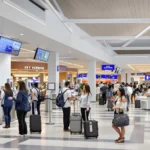You’ve just landed, your phone is buzzing with notifications, and the first thing you look for is the free airport Wi-Fi. We’ve all been there. Connectivity is essential for modern travel, from checking maps and booking rides to confirming your hotel reservation.
But connecting to that network can sometimes feel more complex than solving the most challenging escape room game. You need to understand how to use any public network without worrying about stealing your personal information.
Why is Public Wi-Fi So Risky?
Public networks are “public” in every sense—open, shared, and often unsecured. This makes them a playground for cybercriminals looking for easy targets. Globally, millions of unsecured public Wi-Fi hotspots are available.
Nowadays, a significant percentage of internet users routinely use public Wi-Fi without adequate protection, making them vulnerable to various threats. These unsecured connections create a fertile ground for several types of attacks, from simple data snooping to more sophisticated methods of data theft.
Understanding ‘Man-in-the-Middle’ Attacks
A ‘Man-in-the-Middle‘ (MitM) attack is one of the most common threats. Think of it like a malicious mailman who intercepts your mail, opens it, reads everything, and then sends it.
A hacker on the same network places themselves between your device and the Wi-Fi router. From this position, they can see every activity you do online, including the websites you visit, the passwords you type, and your credit card details.
These are not just theoretical dangers. The threat of “evil twin” attacks, where hackers set up fake networks that cleverly mimic legitimate ones, remains a significant concern for travelers in high-traffic areas.
The High Stakes for Travelers and the Hospitality Industry
Travelers are prime targets, and hotels are a particularly vulnerable spot. The hospitality industry is a frequent and lucrative target for cyberattacks. A 2025 report found that 31 percent of hospitality businesses globally have experienced a data breach, and an alarming 89 percent of those were hit more than once in a single year.
These breaches are often the result of social engineering, unpatched software, and the exploitation of vulnerabilities in connected devices, with guest Wi-Fi being a common entry point. A breach on vacation can be devastating. This isn’t just about losing a password; it can quickly lead to identity theft and significant financial loss, turning a dream trip into a nightmare.
Before You Connect: A Simple 3-Step Safety Check
Think of these steps as the digital equivalent of looking both ways before you cross the street. They are basic habits that can save you a lot of trouble and significantly reduce your risk.
- Verify the network name: Hackers often create malicious networks with names that look official. Before connecting, always ask an employee at the hotel, cafe, or airport information desk for the exact, official network name. This simple check prevents you from walking into a digital trap.
- Tweak your device settings: Your phone and laptop have settings that can automatically leave you vulnerable on public networks. Adjusting them is a critical step to using public Wi-Fi safely.
- Turn Off Automatic Connections: Go into your Wi-Fi settings and ensure your device doesn’t automatically connect to open networks. This puts you in control and prevents you from joining a malicious network without realizing it.
- Disable File Sharing: On Windows, check your advanced network settings, and on a Mac, go to System Settings and look for “Sharing.” Make sure file and printer sharing is turned off. You don’t want to broadcast your files to everyone else in the airport terminal.
- Enable Your Firewall: Most operating systems (OS’s) have a built-in firewall. It is a basic barrier against unauthorized access, so double-check that it is turned on before you connect.
- Stick to secure websites (HTTPS): When browsing, always look for the little padlock icon and “https://” in your browser’s address bar. This indicates that your connection to that specific website is encrypted. While this is a good habit, remember that it only secures your data on that site. It doesn’t protect the rest of your online activity, exposing you to the wider hotel or airport Wi-Fi network.
Your Most Defense: Using a VPN for Total Privacy
A VPN (Virtual Private Network) is the most effective tool for protecting your digital life while traveling. It handles all the major public Wi-Fi security risks.

What is a VPN and how does it work?
A VPN creates a private, protected, and encrypted tunnel for all your internet traffic. Imagine sending your data through a locked, armored truck instead of an open postcard. Even if hackers intercept it, they can’t read what’s inside. The key is powerful encryption, which scrambles your data into unreadable code. This makes your online activity completely private, even on a public network shared with hundreds of others.
The difference between using public Wi-Fi with and without a VPN is stark. Without a VPN, your browsing activity is visible to the network owner and potential hackers, and your passwords and personal data can be intercepted in plain text. Your real IP address and actual physical location are exposed, leaving you vulnerable to multiple cyberattacks.
In contrast, with a VPN, your activity is hidden inside an encrypted tunnel, making it impossible for others to see the sites you visit. Your passwords and personal data are scrambled and unreadable, and your IP address is masked to appear as if you’re in a different location. Overall, a VPN provides high protection against common public Wi-Fi threats.
Why Every Traveler Needs a VPN in 2025
While the safety checklist is a good start, the most complete solution is to use a reliable travel VPN. For travelers, a service like IPVanish is powerful yet incredibly simple, even if you’re not a tech expert. It uses AES-256 encryption, the same security standard used by banks and militaries, to make your data completely unreadable to anyone trying to spy on you on that airport or hotel network.
One of the most significant benefits for travelers, and a key reason it’s considered an excellent travel VPN by many, is its extensive server network. As of 2025, IPVanish offers over 2,400 servers in more than 140 locations worldwide. This allows you to secure your connection and access websites and your favorite streaming services from back home as if you never left. It’s perfect for catching up on your favorite shows during a long layover.
Furthermore, IPVanish has a “Threat Protection” feature that actively blocks malicious websites and annoying ads before they can load, adding another layer of security to your browsing experience. This is achieved through DNS filtering, which consults regularly updated blocklists to prevent connections to known problematic domains.
How to set up IPVanish in 3 easy steps
Getting started with IPVanish is fast and straightforward, ensuring your data is protected in minutes.
- Step 1: Download and Install the App. Go to the IPVanish website or your phone’s app store, just download the app for your device (available for Windows devices, macOS, iOS, and Android), and follow the simple installation prompts.
- Step 2: Log In. Open the app and log in with your account details. This VPN offers a money-back guarantee so you can test-run it risk-free for your next trip.
- Step 3: Connect. Tap the “Connect” button. The app will automatically find the best server for you, or you can choose a specific country from the list. That’s it—your connection is now secure.
Travel Smart, Browse Securely
Free public Wi-Fi is a fantastic travel perk, offering instant connectivity for checking maps or booking rides. However, many public Wi-Fi hotspots are unsecured, making them easy targets for cybercriminals to intercept personal data.
To mitigate these risks, travelers can adopt simple habits and leverage powerful tools like a Virtual Private Network (VPN). A VPN encrypts all internet traffic, creating a private tunnel that shields online activities from prying eyes.
This proactive approach allows individuals to enjoy the convenience of free Wi-Fi without compromising their security. Using a VPN lets travelers focus on their adventures while ensuring their digital life remains protected.


 By
By 




